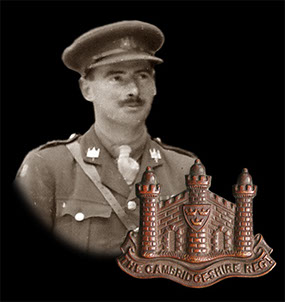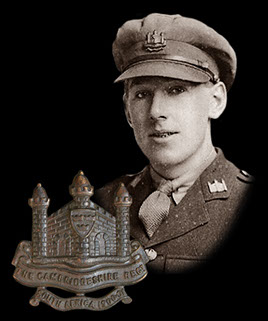
Who Were
The Cambs
The Cambs
at War
1/1st Btn 1914-1919
1914 - 1/1st Overview
1915 - 1/1st Overview
1915 - St Eloi
1915 - Fosse Wood
1916 - 1/1st Overview
1916 - The Schwaben
1916 - St Pierre Divion
1917 - 1/1st Overview
1917 - St Julien
Insignia, Medals & Books
Remembering The Cambs
Biographies
About Us &
This Site
Attacking the Village of Auby – 14th October 1918
The last major action fought by the Cambridgeshire Regiment took place on October 14th 1918 at a coalmining village called Auby, situated on the Haute Deule Canal. It would emphasise the value of experienced officers, but highlight the difficulties of communication caused by two flank battalions of two divisions attacking a village.
From October 8th, the Cambridgeshires, as part of 12th Division, were following the retreating Germans and engaged in mainly patrol encounters (dealt with in a previous article on this site - please click here), for four days before the enemy made a stand on the line of the canal. By October 13th the Cambs, the right flank battalion of 12th Division, were bivouacked between pit heaps in support of the Essex Rgt, which was attacking and clearing Courcelles.
Located a mile and a half to the right was Auby, which was being assaulted by two companies of Northamptonshires of 8th Division, but they could not force an entry and were withdrawn. Auby, which had been practically untouched by the war except for a few practice trenches, was situated in flat grassland with the village taking in adjacent ‘cites’, fosses (pit heaps) and mine buildings. Rows of trees lined the main road. The houses had only recently been vacated by the inhabitants.
As a result, Auby was added to the frontage of the Cambridgeshires and Capt Thomas Harold Harding-Newman, commanding D Company, now tried to infiltrate patrols into the village by working along a railway embankment but heavy machine gun fire halted them 250 yards from the village, and resulted in 2nd Lt John Victor Meyer and his Sergeant being wounded and captured by the Germans. Harding-Newman was a stockbroker’s clerk living in London, who was commissioned into the Cambs Regt in 1915, and spent from late 1916 to the spring of 1918 on secondment as an Assistant Provost Marshall in Glasgow, being drafted to the 1/1st Btn in June 1918. Meyer was an officer from 4th Suffolks who had been attached to the Cambrigeshires almost a month earlier.
Soon it was decided that on October 14th three companies of the Cambs would attack the northern part of Auby and push on to the banks of the canal, while the 1st Worcesters, the left flank battalion of 8th Division, would advance from the south and link up with them. The British would attack behind a creeping barrage that would be fired from a flank, a difficult task with badly worn artillery guns.
The plan was that, after a heavy barrage followed by a pause and then the creeping barrage, A and D Coys would lead the attack to the middle of the village, with C Coy was poised to move through them to the road at the north of the village, while B Coy would then secure a small bridge over the canal. The battalion’s right boundary was the main road running north-south through the village, where the two flanks would meet. The main opposition was expected at the northern end of the village near the minehead and its fosse.
At 10.30pm on October 13th, it seemed the Germans might be retiring, so Capt Charles Tebbutt MC and the acting adjutant Capt Charles Herbert Bowers, whose family ran a leather factory in Sawston, attempted to move B Coy to its assembly position. A German machine gun opened fire from a position assumed to be occupied by the Worcesters forcing the company to retire to their original assembly positions. Unfortunately, two platoons lost their way, resulting in only Lt Henry Hoole and his platoon taking part in the initial assault on October 14th.
On the morning of October 14th, the attack went in at 5.15am with the artillery fire wrongly falling in, behind and in front of the leading companies of the Cambridgeshires. Even though they had casualties from ‘friendly fire’ and from German artillery, they pressed on to their objective in the middle of the village and dug in under the barrage. During the fighting to clear the village, D Coy met the most resistance, taking 40 prisoners. Lt Raymond Robinson of A Coy and Lt Sydney Powditch of D Coy (both recently arrived officers and attached from the Hunts Cyclists) were wounded. That left Harding-Newman (D), Tebbutt (A), Hollis the acting adjutant, 2nd Lts John Ebbutt and Henry Wilkin with C, and Hoole with his platoon of B Coy.
After a pause to let the barrage get ahead, C Coy pressed forward, but found B Coy missing and unable to reach the north of the village owing to a heavy barrage and accurate machine gun fire from the far bank of the canal. A duel between Lewis gunners of the Cambs and the German machine guns ensued. The Germans also exploded an ammunition dump in the village as the British got to the first objectives.
Hollis and Tebbutt discovered that the Worcesters were nowhere to be seen, leaving the battalion across half of the village with its right flank exposed and resting where the houses were thickest with no suitable positions for a defensive flank. A party of A Coy under Pte (acting Cpl) Clarence Smith, from Histon, set up a post at the village crossroads, but had to retire owing to heavy shellfire. For his efforts, Smith was awarded the Military Medal.
At 9am Tebbutt and an orderly tried to get down the central street towards the village’s main bridge, but the Germans had set up a barricade across the street and fired on them. Before this information could be passed back, Hollis and Wilkin had made a similar attempt resulting in the latter being wounded. Hollis managed to get Wilkin, who was from Cambridge and had been at the front only a month, to safety.
Next, the three coy commanders met in a cellar in the village to discuss their next move, only to hear that a party of Germans had crossed the light bridge that was the C Coy objective. Owing to its exposed position, it was decided C Coy should retire across 300 yards of open ground to a position on the right of A Coy. This was done under fire from up to five German machine guns at 500-600 yards range, and with the loss of two or three men. The coy was reorganised in houses to continue A Coy’s line.
Capt Tebbutt, writing in 1924 about the attack, wrote: The action thereupon more or less died away, though anxiety was still felt for the right flank. This was about 1.15pm. Tebbutt’s account of the attack formed the basis of much of the account in the battalion’s history The Cambridgeshires’. Shelling continued, intermittently, during the afternoon, especially on A and D Coys, while C Coy was being hit by British artillery fire as low trajectory shots aimed at the centre of the village hits the tops of houses and burst over their posts.
In the afternoon the position was strengthened when Lt Alfred Geater and more men of B Coy arrived, along with some machine gunners. A stokes mortar also helped keep down the German snipers. Capt Hollis, who now had four machine guns and up to 12 Lewis guns at his disposal, reported that his flank was safe.
At 4.30pm orders were received for a fresh assault, but owing to the short notice, lack of men and fatigue, the three coy commanders reluctantly reported they could not do so without more time to prepare. C Coy and the men from B Coy then extended their line to the village cemetery, located in the neighbouring division’s frontage, and at 7pm linked up with the Worcesters. 2nd Lt William George Linsey, of B Coy, who was from Cambridge, was wounded in the leg.
The following day produced only slight shelling and machine gun fire and the battalion was relieved by the Norfolks at about 8.30pm.
For his conduct at Auby, Capt Harding-Newman was awarded the Military Cross. His citations states: He led his company with marked gallantry and determination, and successfully captured his objective and took over forty prisoners and three machine guns from a very strong position. Later, he personally led a platoon to clear up the situation, and obtained valuable information. Although his company was heavily shelled, he maintained his position and beat off all enemy attempts to turn his flank.
There was a Distinguished Conduct Medal for L/Sgt Walter Charles Parry MM, for his gallantry when: He led half the company. He mopped up the right half of the company sector under very heavy fire, and from one house alone captured 20 prisoners and killed or wounded nearly a dozen of the enemy. His initiative and resource materially contributed to the success of the day’s operations. Parry, who was from Bramfield, Suffolk, had seen service with 4th Suffolk on the Western Front from November 1914 and was wounded in 1915, later serving with 7th Suffolk and for bravery in 1917 received the Military Medal. He was one of the men from the disbanded 7th Btn that were posted to the Cambridgeshires in May 1918.
There was also Military Medals awarded for the action at Auby. Among them were Pte Smith (mentioned earlier) and Pte Lewis Sammons, from Outwell, near Wisbech, who received the award for his efforts in clearing the village.
As well as the officer casualties already stated, nine other ranks were killed, one died of wounds and 45 were wounded, with one man missing. Four more were wounded before the relief on October 15th. Five of the wounded from the action would die of their wounds between October 15th and 18th.

Lt Col Clayton DSO, Battalion CO.

2nd Lt William Linsey, from Cambridge, wounded during the fighting in Auby.

This site went live on the 14th February 2015 to mark 100 years since the 1/1st Cambs went off to war.
WE WILL REMEMBER THEM
Email us: cambsregt@gmail.com
Copyright 2015, 2016, 2017, 2018, 2019 by Felix Jackson. The information and images on this site should not be reproduced without prior permission.